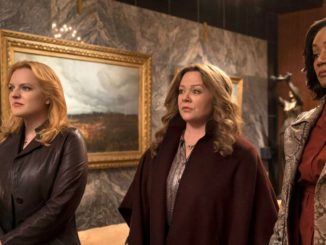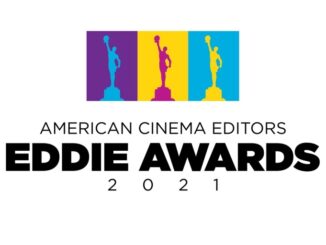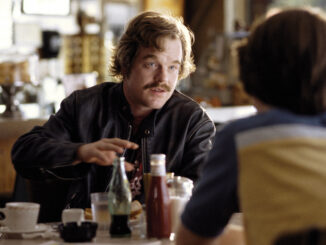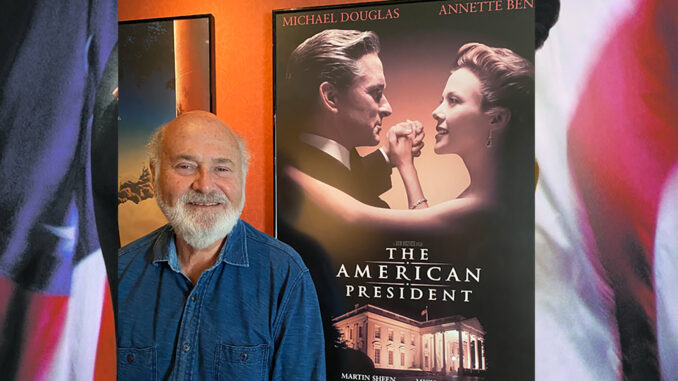
by A.J. Catoline
“We have serious problems to solve, and we need serious people to solve them,” says the President of the United States at the White House podium. “I was so busy trying to keep my job, that I forgot to do my job.”
This isn’t the current occupant of the Oval Office, but President Andrew Shepherd, played by Michael Douglas, in “The American President,” which celebrates its 25th anniversary this November. Directed by Rob Reiner and written by Aaron Sorkin, the movie still resonates today as we approach what many are calling one of the most critical elections in American history.
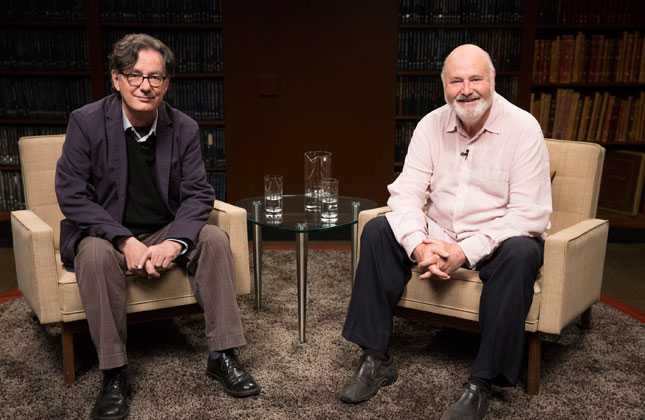
So CineMontage chatted with director Rob Reiner and editor Robert Leighton, who collaborated together in the cutting room for 15 films — including “This is Spinal Tap,” “Stand By Me,” “The Princess Bride,” “A Few Good Men” and “The Bucket List.”
“In this period, it was a great film to watch again,” Leighton said.
The movie’s President Shepherd is a charismatic leader who speaks truth in lofty prose to the American people. That’s a contrast from the real President Trump, who’s often criticized for presiding over a chaotic West Wing of incompetence and speaking in a rambling word-salad of falsehoods that distract and divide the country.
CineMontage Magazine has written before about the intersection of politics and trade unionism. Collective bargaining is strengthened or weakened by the lawmakers who win elections.
If Union members are discouraged by the current political climate in the country – or longing for leadership of an American president – they could be inspired to re-watch, or stream for the first time, a film that President Barack Obama once called an “Aaron Sorkin liberal fantasy.”
‘What a real democracy can be’
Leighton noted the contrast between the movie’s reality and the present state of affairs. “The way the West Wing and the White House were visualized, it was all very brightly lit, it wasn’t cast in shadows, and there’s no chicanery going on,” he said. “There were real people, who work very hard, and who are sharp, and moral. And there’s a romance, and it’s a comedy. I thought ‘did I die and go to heaven?’”
“I think people should watch the film and see what a real democracy can be,” said Reiner. “The story is about making a more perfect union. As a country we’re not perfect, and President Andrew Shepherd is not perfect. But he’s striving for a more perfect union. And that’s what we all should be striving for. People should watch the film and maybe it will inspire them.”
In February, the Sedona Film Festival screened “The American President” in the battleground state of Arizona. Many in the audience were first-time viewers, not yet voting age when the film came out in 1995.
“The audience reaction to the film was way better than when it first came out. I mean, way better!” said Reiner. “People were reacting like crazy to this film. Because of what is happening in the country now, because of who we have in the White House, people said ‘wow!’ This is what a president is supposed to be!”
Speak the speech
The climax of “The American President” might be among the best political speech scenes in movie history. The president is charmed by an environmental lobbyist named Sidney Ellen Wade, played by Annette Bening. The president’s wife died before he took office, and he is a single-dad raising his daughter in the White House. He falls in love with Wade, and the media becomes consumed with the president’s new girlfriend.
The scandal does not rise to impeachment, collusion or tax fraud, yet his Republican opponent — Senator Bob Rumson (Richard Dreyfuss) — attacks the president on character and morality. Opposition research uncovers that Wade joined a protest in her youth where an American flag was burned. Senator Rumson goes on television and implies she is an unpatriotic whore.
President Shepherd struggles not to engage and be presidential. Yet he storms to the press room and lays it all on the line. Though the film may be a “liberal fantasy,” this scene is adored by both Republicans and Democrats with many views on You Tube.
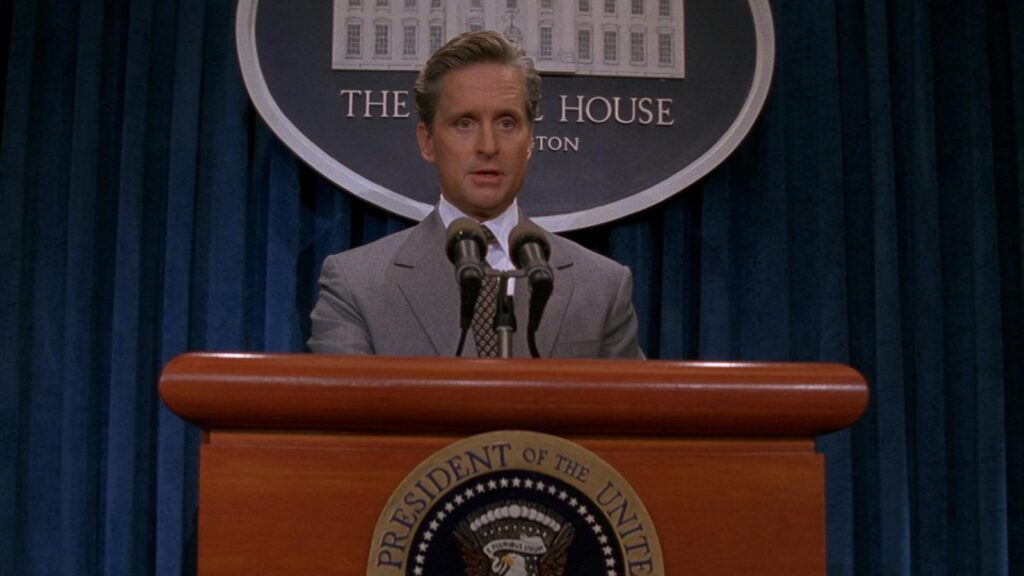
“America isn’t easy,” the president says, staring down the lens in a tight close shot. “America is advanced citizenship. You have got to want it bad because it’s going to put up a fight. It’s going to say, ‘you want free speech? Let’s see you acknowledge a man whose words make your blood boil who is standing center stage and advocating at the top of his lungs that which you would spend a lifetime opposing at the top of yours. You want to claim this land is the land of the free? Then the symbol of your country cannot just be a flag. The symbol also has to be one of its citizens exercising his right to burn that flag in protest.’”
Leighton was surprised by how short the speech seemed, but he recalled “it was a gargantuan scene to put together. The moment about burning the flag was really powerful.”
“Today the film loses none of its currency,” said Reiner. “Protests on the street, the Black Lives Matter movement, started when a man kneeled to protest the national anthem. Nothing’s changed.”
During the recent protests, President Trump said he wanted flag burning to be punished. When journalists informed him the Supreme Court ruled in 1989 that is protected free speech, Trump said the justices should review the decision. The president’s nominee for the Supreme Court, Judge Amy Coney Barrett, once clerked for Justice Antonin Scalia who sided with the 5-4 majority that burning the flag is protected by the First Amendment.
Back in the cutting room at Castle Rock in 1995, Leighton remembers Reiner had envisioned the film in his mind before he shot it. “Being an actor before being a director, Rob learned the grammar of film very well – wide shot, close up, over the shoulders, POV, whatever you needed – it was there. And there were a good number of takes,” said Leighton. “The challenge was finding the right tempo and performance so it flowed perfectly.”
“Bob and I had the exact same philosophy about editing,” said Reiner. “You start with the emotional core of the scene, and you put the audience where you want them to be. It’s not just random that you are cutting to make it look interesting visually, you put the camera on who you want them to see at a certain point of time. And we were both on board for that.”
“Rob was a real stickler for performance,” Leighton remembers. “Nobody was ad-libbing along the way, not with an Aaron Sorkin script. We edited words from other takes on to the end of a sentence so there would be the correct cadence, like a voice going down instead of up. We made the dialog work perfectly. In the end, it wasn’t flashy, it just played smoothly, but dramatically. It was a really good speech! When you get a guy like Michael Douglas, it gets really good.”
And Sorkin’s dialogue is relevant to the 2020 election.
“I can tell you without hesitation,” says President Sheperd, “being president of this country is entirely about character.” Presidential candidate Joe Biden has made similar points. In the movie, referring to his Republican opponent, President Sheperd says: “He is interested in two things, and two things only – making you afraid of it, and telling you who to blame for it.” President Trump launched his political campaign in 2016 by blaming “Mexican rapists.” In 2018, he fear-mongered that a “caravan” would appear on the border, though none ever did. And he blames the COVID crisis on China, the media and “blue state governors.”
For the last 25 years, “The American President” has united movie fans on the left and the right. In the 2016 primaries, Trump mocked the appearance of Senator Ted Cruz’s wife. Cruz paraphrased a portion of the film speech: “If Donald wants to get into a character fight, he’s better off sticking with me because Heidi is way out of his league.”
Last month Reiner re-united with the some of the cast of “The Princess Bride” for an online script reading to raise money for the Wisconsin Democratic Party. Cruz tweeted his disapproval for what he called a “perfect movie” being used for politics. Reiner brushed aside the criticism, saying at the event: “We’re here to get Donald Trump out of the White House. That’s the main goal. And it’s all hands on deck!”
Going digital
Leighton edited “A Few Good Men” (1992) on film, and “The American President” was his first feature cut on then emerging software Avid Media Composer. It was much easier cutting a Sorkin film with lots of dialogue on Avid than on a flatbed K-E-M.
“On ‘A Few Good Men,’ we had reels of footage,” remembered Leighton, “especially the Jack Nicholson courtroom scene (“You can’t handle the truth!”) There were stacks of reels of single takes of the lines, and we had to take that roll off and check 800 feet down and find out he screwed up that line. We would take the rolls half-way down without rewinding all the way. And we were shifting film-spaghetti all over the cutting room. So when we got on Avid it was so much easier! And I had a very good assistant editor.”

Alan E. Bell, ACE, began his editing career as an assistant to Leighton on “Misery” (1990) and was promoted to Associate Editor on “The American President.” Reiner asked him to help create a digital workflow for his next Sorkin film.
“I was also the post-production supervisor on the film, which may seem like a conflict of interest, but at Castle Rock back then it didn’t seem that way,” recalls Bell. “Rob was a partner, so he pretty much was the boss. Whatever he wanted, we got. Bob and Rob brought me into the room and said, we want to cut digital next, please figure out what system is best. And we decided on Avid.”
“Alan was one of these people who had grown up building a computer when he was 8 years old, writing his own code, he was totally into it,” remembers Leighton.
“I had a digitized log book before anybody ever thought that was clever,” said Bell. “Aaron Sorkin’s dialogue is meant to be overlapped, and overlapped really tightly. Having the ability of two-frame digital dissolves that you couldn’t do on a K-E-M helped quite a bit.”
“Though we didn’t have script-sync back then, it still was relatively more simple,” said Leighton. “And it was like, wow I’m driving a sports car when I used to have a Bug! For me it was great having someone like Alan, both an Avid expert and someone who knew all about editing.”
“Bob had a lot of digital questions about the Avid,” remembers Bell. “And he didn’t want to always call me on the phone, especially when sitting with Rob. He asked me to get a doorbell that used a light instead of a ringer. And we glued this doorbell button under his Avid desk. I had the light at my bench, where we were chasing the Avid because we still screened on film print. Whenever Bob had a question and needed me in the room, Bob would hit the button. Rob Reiner always said, ‘Alan you have this amazing ability! Whenever you are needed, you just come in the room. How do you do it?’ I said, ‘it’s just a sense, I guess, Rob.’ I don’t think he ever discovered our trick!”
Reiner agrees cutting on Avid was an improvement, and that cutting on film “would take forever. When I saw Avid, I said ‘this was the best thing ever.’”
For example, cutting on film “all the reels of a particular scene would pile up,” Reiner remembered. “When we finished a reel and it was done, we had this harmonica which was in the shape of a plastic lobster claw. Once we were finished with a reel, I would blow the lobster claw three times. And that meant the assistants had to stop whatever they were doing and, like a bucket-brigade, Bob would throw the reel at me and I would throw them out into the hall. And we would start flinging these reels, one after the other into the hallway.”
Though one day, Alan and the assistants did not answer the harmonica call. Alan was upstairs, suffering from an asthma attack. Another assistant editor was helping to administer his medicine.

“We couldn’t come running down,” recalls Bell. “And we kept hearing ‘ka-klunk! ka-klunk!’”
Reiner remembered thinking at first, “Didn’t they remember the rule? You had to stop everything! I didn’t know where Alan was, but we kept flinging the reels, bouncing all over the hallway. I had no idea he was up there having an asthma attack!”
Bell said with a laugh, “It was one hell of a mess to clean up! It was 20-30 reels, and six or seven had dropped cores. It was all in good fun. Those were the days, we really had a blast.”
After completing “The American President,” Bell and Leighton presented Reiner with the lobster claw harmonica mounted in a glass box as a gift. The days of digital editing no longer required this tool.
With the new Avid software creating efficiency and speed, Bell remembers this allowed extra time to try new ideas with the film. It also allowed time to take breaks away from the cutting room to bond together as a crew. “Rob and Bob insisted — we always went out to lunch together,” recalled Bell. “We rarely ordered food in. We always got in the car and drove somewhere for lunch.” (Destinations included the noted Hollywood hangout Musso & Frank, profiled by CineMontage last year.)
United for the Vote
In the race for the next American president, Reiner’s Twitter account has lit up the internet. On Labor Day, he wrote:
“The most important job for all of us Union Workers is to mobilize and elect a true working man’s friend, Joe Biden. We have… to rid US of a Criminal with a long history of stiffing hard working Americans.”
“I’m doing as much ‘good trouble’ as I possibly could do,” Reiner told CineMontage.
Reiner tweeted while the president was in the hospital: “You learned a lot about Covid? Really? It’s only real if it happens to you? 210,000 people are dead!! It’s a little late, schmuck!”
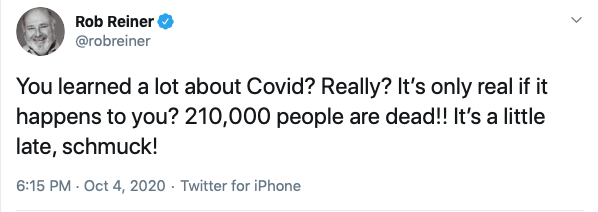
Last year during the impeachment inquiry, Reiner joined The Committee To Investigate Russia to lay out the case “that a foreign power came in and disrupted our election. There’s no getting around this fact,” Reiner told CineMontage. “There was no criminal conspiracy, but there was collusion. Hard-core collusion. But the Republican Senate didn’t care. And that’s insanity.”
And what will make union members care to get out and vote?
Reiner says to look to the words of President Andrew Shepherd. “You’ve got to want America bad! Do they want a democracy or not?” Reiner asked. “If they want an autocrat fine. Then they will vote for Trump and will have what they have in Russia or North Korea. If you want a democracy, then you must vote for Biden.”
If Andrew Shepherd were in the debate against Trump he would presumably tell him what he told his opponent in the film: “This is a time for serious people. And your 15 minutes are up.”


